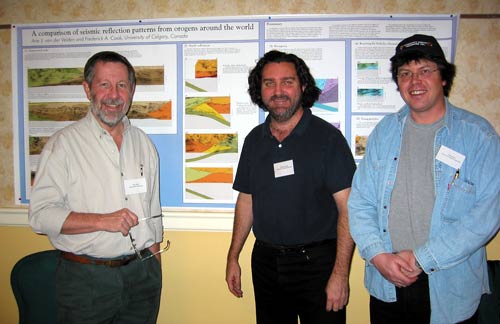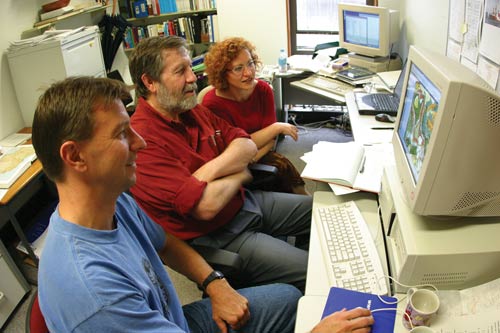Industry Interaction
|
|
Industry interaction, technology transfer and commercialisation program Gemoc relies on a vigorous interaction with the mineral exploration industry at both the research and the teaching/training levels. The research results of the Centre’s work are transferred to the industry and to the scientific community by:
• GEMOC (Macquarie) is the Agilent Technologies ICPMS Australian demonstration site • GEMOC (Macquarie) is the
international Alpha test site for New Wave Research Lasers Support sources GEMOC industry support includes:
Progress in 2002 TerraneChronTM studies (see inset in Research Highlights) are rapidly being adopted by the mineral exploration industry. This methodology, currently unique to GEMOC, requires the integration of data from three instruments (electron microprobe, LAM-ICPMS and LAM-MC-ICPMS) and delivers fast, cost-effective information on the tectonic history (with ages) of regional terrains. Collaborative research with Kennecott Canada Inc., continued within the Lithosphere Mapping strand, following the very successful SPIRT project “Lithosphere Mapping and Diamond Exploration”. This involved the analysis of heavy mineral concentrates from more than 25 localities scattered around North America, and the correlation of the data with seismic tomography and other geophysical data (see Research Highlights). Results of the SPIRT project were finalised for release at the 8th International Kimberlite Conference in Vancouver in June 2003. Ten Industry Reports were completed for collaborative and consulting projects. An ARC SPIRT project (2001-2003) sponsored by WMC uses gravity data to interpret effective elastic thickness and integrates this with tectonic analysis and geochemical data across Australia. In 2002 the focus of this project was expanded to include the detailed analysis of lithosphere structure and evolution worldwide, using seismic tomography and other geophysical datasets. Planning and workshop sessions at Macquarie with participants from WMC and GEMOC, and a visit by Macquarie staff to WMC in Perth, were key activities. WMC have engaged GEMOC for a major TerraneChronTM project studying crustal evolution in South America. DeBeers (Johannesburg), who provided contributory capital funding for the MC-ICPMS laboratory, continued a schedule of regular visits to Macquarie to participate in aspects of the development of LAM-ICPMS and MC-ICPMS techniques and applications. U-Pb dating of zircons by LAM-ICPMS and the trace-element analysis of diamonds were again the focus of interaction with DeBeers in 2002. A new PhD student (Sonal Rege) commenced a study of trace elements in diamonds with samples provided by Professor J. Harris on behalf of de Beers. The exploration consulting group GeoDiscovery is actively working with GEMOC to develop TerraneChronTM, a novel approach to terrane analysis (see Research Highlights). A GeoDiscovery/Macquarie collaborative project supported the initiation of this project, and a Pasminco/GEMOC collaborative grant, brokered by GeoDiscovery, continued the program. A new collaborative project, negotiated in 2002 and supported by BHP-Billiton, will begin early in 2003 (see summaries of current industry projects below). Dr Steve Walters visits Macquarie to participate in this collaboration. Many companies have provided high levels of in-kind support in the form of samples: these include access to diamonds and xenoliths through Rio Tinto and Kennecott Canada, suites of xenoliths from Ashton Mining of Canada and heavy mineral concentrates from numerous sources including BHP, DeBeers Australia, Monopros and several small companies. Numerous industry visitors spent varying periods at GEMOC in 2002 to discuss our research and technology development (see visitor list, Appendix 3). DIATREEM continued to provide LAM-ICPMS analyses of garnets and chromites to the diamond-exploration industry on a routine basis, in cooperation with CSIRO, North Ryde. GEMOC publications, preprints and non-proprietary reports are available on request for industry libraries. |
||||
| Current
industry-funded collaborative research projects |
|
||||
Pondering deeply ….below the surface: Graham Begg (WMC), Bill Griffin and Tara Deen. |
Lithospheric architecture of Australia: relevance to location of giant ore bodies Supported by an ARC SPIRT grant Industry Collaborator: WMC Summary: This research project is designed to test the concept that giant magmatic and hydrothermal ore bodies are localised by major structural discontinuities that extend through the Earth’s lithosphere. Modelling of geophysical data across the Australian continent is defining regional trans-lithospheric domains and their boundaries. Tectonic analysis and geochemical data on crustal and mantle rocks are defining the age and composition of the upper mantle beneath each domain, and the history of crust-mantle interaction (magmatism, extension, compression). This history will be integrated with information on the timing and style of large ore deposits to understand the relationship between lithosphere domains and large-scale mineralisation. The focus of this project was expanded in 2002 to include the detailed analysis of lithosphere structure and evolution worldwide, using seismic tomography and other geophysical datasets.
|
||||
|
Supported by a matching Macquarie University Collaborative grant Industry Collaborator: BHB-Billiton Summary: This project is aimed at understanding processes of Proterozoic crustal formation. We will measure the U-Pb ages, Hf isotope ratios and trace-element patterns of detrital zircons from selected Proterozoic terranes, to study the timing, nature and sources of magmatic rocks. The Event Signature for each region will be compared with our data from geologically similar districts, eg Mt. Isa block (Australia) and Arivalli Craton (India), and event styles will be correlated with differences and similarities in known mineralisation styles. The project will contribute to a unique global ‘library’ of Event Signatures with application to area selection for mineral exploration.
|
|||||
|
Supported by a matching Macquarie University Collaborative grant Partners: Geological Survey of Norway and the University of Oslo Summary: The broad-scale evolution of the Proterozoic crust of southern Norway is being investigated, using U-Pb, Hf-isotope and trace-element analysis of zircons from selected bedrock units and the overlying Neoproterozoic Sparagmite sedimentary sequence. The results will provide an “Event Signature” for comparison with similar data from more strongly mineralised Proterozoic crust elsewhere. Signatures from small modern drainages in the study area will be compared with those from the rock samples to test the usefulness of this approach for the study of crustal evolution in glaciated areas. The results will enhance the technique’s applications to mineral and energy exploration.
|
|||||
|
Supported by a matching Macquarie University Collaborative grant Partner: Geological Survey of Western Australia Summary: In situ microanalytical techniques are being used to determine the age and Hf isotopic composition of zircons from a series of ancient sedimentary rocks and selected igneous rocks from the Archean Pilbara and Yilgarn cratons, and the Proterozoic Capricorn Orogen that separates them. The data will provide a broad picture of the nature of crustal evolution in this region over the first 2.5 billion years of Earth history, and contribute to a better understanding of the early development and evolution of continents. The project also will evaluate the applicability of these methodologies in studies of the development of sedimentary basins.
|
|||||
|
Supported by AMIRA (Project P515) Industry Collaborators: Newcrest, Rio Tinto, Delta, GA, NSWGS, QDME, Triako Normandy Summary: This project provided the first compilation and synthesis of granite compositional data for the whole of the eastern Australian Tasmanides. The data also provided the basis for a “first pass” igneous metallogenic overview of these granites with particular reference to recognising provinces that may be fertile for previously unrecognised deposit types. Databases of igneous rocks associated with large to world class ore deposits of Cu, Au, Sn, W and Mo were compiled and used as templates to help assign metallogenic potential to granite suites and to help recognise under-explored regions within eastern Australia. Improved data on ore forming elements in granites have been obtained from new XRF facilities at GEMOC under the supervision of Professor Bruce Chappell. The application of new techniques (LA-ICP-MS trace elements, U-Pb dating and Lu-Hf isotopes) to aspects of granite related hydrothermal systems has been employed and user-friendly field-based techniques to investigate the metallogenic potential of intrusives have also been developed. This project was successfully completed in 2002 with the distribution of the final report. One outcome of the project will be a granite workshop and symposium to be held at GEMOC in July, 2003.
|
|||||
Buddy Doyle and Kevin Kivi from Kennecott at a Lithoprobe (Canada) workshop with Bill Griffin |
Supported by Kennecott Canada Summary: This project is featured in the Research Highlights in this Report. The compositional structure of the subcontinental lithospheric mantle (SCLM) beneath the North American Plate (USA, Canada, W. Greenland) has been mapped in 3D using major- and trace-element data on Cr-pyrope garnets from ca 100 kimberlites, lamproites and lamprophyres in 26 areas. A statistical classification scheme (Griffin et al., G3, 2002) allows mapping of garnet compositional populations with depth to produce SCLM sections, which show the distribution of rock types and metasomatic processes. Inversion of a garnet-olivine thermometer developed in GEMOC (Publication #222) has been used to map the variation in mean XMgolivine with depth. Note: GEMOC’s methods have been instrumental in Kennecott’s
discovery of new diamond-bearing kimberlites in northern Canada.  |

 GEMOC ARC National Key Centre
GEMOC ARC National Key Centre



